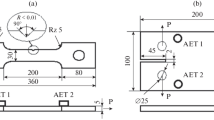Abstract
A theoretical substantiation of the acoustic curve of growth of fatigue cracks is presented, including the main assumptions and the dependence of the amplitude of surface acoustic wave oscillations on the number of cycles in cyclic tests. It is shown that this dependence does not qualitatively contradict the classical theory of crack growth from notches. A criterion for previous damage intended for ensuring timely replacement of a fatigue-damaged article is considered. This criterion is implemented using the backscattering (acoustic fatigue curve) and signal-oscillation methods. It is asserted that the signal-oscillation method is an active low-frequency analogue of the acoustic-emission method.
Similar content being viewed by others
References
Busov, V.L. and Shermergor, T.D., Scattering of Ultrasonic Waves in Polycrystals under Conditions of Developed Plastic Deformation at the Fragmentation Stage, FTVD, 2002, vol. 12, no. 1, p. 60.
Busov, V.L., Absorption of Ultrasonic Waves in Plastically Strained Polycrystals, FTVD, 2005, vol. 15, no. 1, p. 112.
Busov, V.L., Scattering of Ultrasonic Waves in Plastically Strained Polycrystals, Acoust. Vestnik NANU, 2007, no. 3.
Hirotsugu, O., Yoshikiyo, M., and Masahiko, H., Acoustic Study of Dislocation Rearrangement at Later Stages of Fatigue. Noncontact Prediction of Remaining Life, J. Appl. Phys., 2002, vol. 91, no. 4, p. 1849.
Konovalov, S.V., Gorlova, S.N., Leikina, O.S., Sosnin, O.V., Tsellermaier, V.V., and Gromov, V.E., Dependence of the Ultrasound Propagation Velocity on the Number of Cycles in Fatigue Tests, 3-ya Vserossiiskaya nauchnotekhn. konferentsiya “Novye khim. tekhnologii: proizvodstvo i primenenie” (Third All-Russia Scientific and Technical Conf. “New Chemical Technologies: Production and Application”), Penza: Privolzh. Dom znanii, 2000, pp. 25–26.
Gretskaya, I.A., Konovalov, S.V., and Sosnin, O.V., Possibility of Plotting Fatigue Curves from the Data of Ultrasound Velocity Measurements, Izv. Vuzov. Chern. Mettalurg., 2002, no. 11, p. 77.
Budenkov, G.A., Nedzvetskaya, O.V., and Bakhtin, A.V., Acoustics of Growing Cracks, Vestnik Izhevsk. gos. tekhn. Univer., 1998, no. 1, pp. 20–26; Budenkov G.A., Nedzvetskaya O.V., and Kotolomov A.Yu. Quantitative Evaluation of the Crack-Growth Process Based on the AE Phenomenon, V Mire Nerazr. Kontr., 2001, no. 2, pp. 16–19.
Penkin, A.G., Tenent’ev, V.F., and Maslov, L.I., Otsenka ostatochnogo resursa rabotosposobnosti trubnykh stalei s ispol’zovaniem metodov akusticheskoi emissii i kineticheskoi tverdosti (Evaluation of the Residual Life of Tube Steels using Acoustic-Emission and Kinetic-Hardness Methods), Moscow: Interkontakt Nauka, 2005.
Bezlyudko, G.Ya., Operational Testing of the Fatigue State and Residual Life of Metalware by the Nondestructive Magnetic Coercimetric Method, Tekhn. Diagnost. Nerazr. Kontr., 2003, no. 2, p. 20.
Masatoshi, K., Shinsuke, Y., Koji, Yamada., and Yoshihiro, I., Evaluation of Residual Stresses and Plastic Deformation for Iron-Based Materials by Leakage Magnetic Flux Sensors, J. Alloys Compd., 2000, vol. 314, nos. 1–2, p. 232.
Gorkunov, E.S., Khamitov, V.A., and Bartenev, O.A., Magnetoacoustic Emission in Plastically Strained Ferromagnets, Defektoskopiya, 1988, no. 9, p. 10.
Mori Akira, Iwasa Sinichi, and Suzuki Kaoru, The Basic Study of the Detection of Metal Fatigue by Laser Insituted Thermal Vibration (report), Conf. on Engineering Thin Films with Ion Beam, Nanoscale Diagnostics and Molecular Manufacturing, San Diego, Calif., 2001, Proc. SPIE201, 4468, p. 171–178.
Rybnik, A.A. and Ermolov, I.N., Substantiation of Optimal Methods for Ultrasonic Evaluation of the State of a Material Subject to a Cyclic Damage, Trudy TsNIITMASh, Moscow, 1981, no. 165, pp. 42–59.
Rybnik, A.A., Ermolov, I.N., and Tsarev, K.K., A Setup for Ultrasonic Investigation of Stages of Metal Fatigue Development, Trudy TsNIITMASh, Moscow, 1981, no. 165, pp. 42–59.
Vladimirov, V.I., Fizicheskaya priroda razrusheniya metallov (Physiacal Nature of Metal Fracture), Moscow: Metallurgiya, 1984.
Ivanova, V.S. and Terent’ev, V.F., Priroda ustalosti metallov (Nature of Metal Fatigue), Moscow: Metallurgiya, 1975, p. 48.
Pavlov, V.A., Amorphization of Metal and Alloy Structures with a Maximum Possible Degree of Strain, Fiz. Met. Metalloved., 1985, vol. 59, no. 4, p. 629.
Tutnov, A.A., Dorovskii, V.M., and Elesin, L.A., Amorphization of Crystal Materials in the Zone in Front of the Tip of a Developing Crack, in Sinergetika i ustalostnoe razrushenie metallov (Synergetics and Fatigue Fracture of Metals), Moscow: Nauka, 1989, p. 45.
Tong, Z.X. and Bailon, J.P., Fatigue and Fract. Eng. Materials and Structure, 1995, vol. 18, nos. 7–8, p. 847.
Rybin, V.V., Bol’shie plasticheskie deformatsii i razrushenie metallov (Large Plastic Deformations and Metal Fracture), Moscow: Metallurgiya, 1986.
Viktorov, I.A., Ul’trazvukovye poverkhnostnye volny v tverdykh telakh (Ultrasonic Surface Waves in Solids), Moscow: Nauka, 1981.
Koppelmann, J. and Fay, B., Die Quantitative Auswertung Von Ultraschall Ruksstrenuungmessungen in Metallen, Acustica, 1973, vol. 29, p. 297.
Kotsan’da, S., Ustalostnoe rastreskivanie metallov (Fatigue Cracking of Metals), Moscow: Metallurgiya, 1990, p. 400.
Smith, S. and Kobayasi, A., Eksperimental’naya mekhanika razrusheniya, in Eksperimental’naya mekhanika, v 2-kh kn. (Experimental Mechanics), Kobayasi, A. Ed., Moscow: Mir, 1990, vol. 2, p. 440.
Rybin, V.V. and Zhukovskii, I.M., Disclination Microcrack Formation Mechanism, Fiz. Tverd. Tela (St. Ptersburg), 1978, vol. 20, no. 6.
Ivanov, V.I. and Belov, V.M., Akustiko-emissionnyi kontrol’ svarki i svarnykh izdelii (Acoustic-Emission Testing of Welding and Welded Objects), Moscow: Mashinostroenie, 1981, p. 184.
Rybnik, A.A., Ermolov, I.N., and Zaitsev, G.Z., Ultrasonic Method for Testing Specimens in Fatigue Tests, Zavod. Lab, 1981, no. 5, p. 75.
Author information
Authors and Affiliations
Additional information
Original Russian Text © V.L. Busov, 2008, published in Defektoskopiya, 2008, Vol. 44, No. 9, pp. 64–69.
Rights and permissions
About this article
Cite this article
Busov, V.L. Acoustic analogue of the curve of growth of fatigue cracks. Russ J Nondestruct Test 44, 634–638 (2008). https://doi.org/10.1134/S1061830908090076
Received:
Published:
Issue Date:
DOI: https://doi.org/10.1134/S1061830908090076




